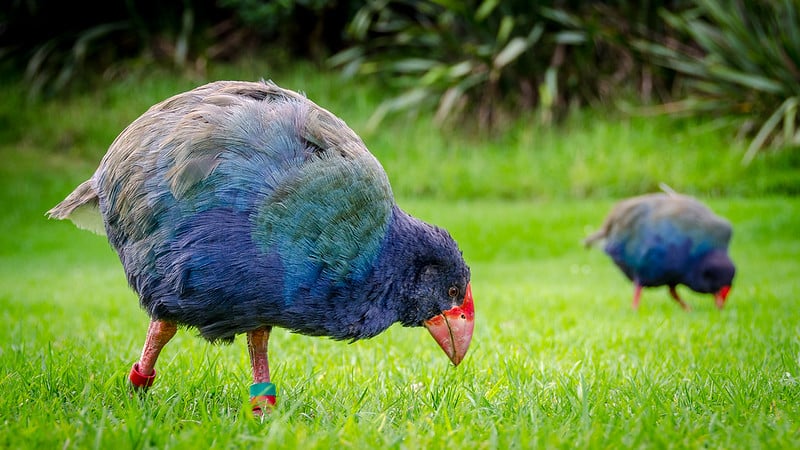
The recent release of eighteen Takahē birds in the Lake Whakatipu Waimāori Valley on New Zealand’s South Island holds immense significance. These large, flightless prehistoric bird species were once thought to be extinct and had not been seen roaming these alpine slopes for nearly a century.
More about the flightless birds
Takahē, the unique creatures of New Zealand, stand out for their exceptional qualities. These birds, like many others in New Zealand, developed without the company of land mammals.
Instead, they adapted to take on the roles that mammals usually play in the ecosystem. These birds cannot fly and have an average height of about fifty centimeters.
Records show that they’ve been part of Aotearoa since ancient times, dating back to the prehistoric Pleistocene era, as suggested by remains found in fossils. Describing them, Tūmai Cassidy from Ngāi Tahu mentions, “They’re almost prehistoric looking.”
When you look at them from the front, their bodies can seem almost perfectly round. With their blue-green feathers, they resemble a miniature Earth placed on top of two long, bright red legs. As O’ Regan, an elder from Ngāi Tahu, reflects, “Someone once called us, the land of the birds that walk.”
Conservation success in New Zealand
In New Zealand, a notable conservation success story is unfolding as the once-lost takahē birds are making a slow comeback. These birds, among the rarest in the world, had been declared extinct back in 1898.
Their numbers had been severely reduced due to the introduction of animals like stoats, cats, ferrets, and rats by European settlers. However, in 1948, they were rediscovered, and since then, their population has been steadily increasing.
Today, there are around five hundred takahē birds, and their numbers are growing by approximately eight percent each year. This marks a significant achievement for conservation efforts in the region.
Collection and incubation by conservationists
At the start, conservationists took a proactive approach by collecting and carefully incubating the eggs. This was done to shield them from being consumed by predators. As the eggs hatched, special attention was given to feeding and nurturing the chicks.
Workers, wearing sock puppets resembling the birds’ unique red beaks, played a crucial role in this process. Later on, the strategy shifted towards breeding the birds in controlled environments.
The Department of Conservation (DOC) gradually introduced these birds to select island sanctuaries and national parks.
To ensure their safety, substantial efforts were invested in setting up traps and removing pests that posed a threat to the birds’ survival. This endeavor reflects a significant commitment to safeguarding these precious creatures.
“Trapping of stoats, ferrets and feral cats has knocked down predator numbers,” stated Deidre Vercoe, who oversees the Takahē recovery operations at the Department of Conservation (DOC). “Sustaining this low predator count remains absolutely vital.”
New pairs set free to expand takahē birds population
In a recent development, newly arrived pairs of takahē birds have been introduced to their new surroundings. The aim is to bring about the release of an additional seven birds in the upcoming month of October.
Furthermore, plans are in place to release as many as ten young takahē birds in the early months of next year. Dr. Vercoe, who is closely associated with this initiative, expressed her cautious optimism.
Lovely to see this handsome new takahē couple join @Wellington_NZ predator free bird sanctuary @ZEALANDIA. 3 yr old Waitaa and 6 yr old male Bendigo join takahē Neo and Orbell at the sanctuary, after arriving by air from the Burwood Takahē Breeding Centre in @TeAnauNZ @docgovtnz pic.twitter.com/ODbjdsQPfR
— Wendy Hinton (@HintonWendyNZ) August 29, 2023
She acknowledged the decades of dedicated work that has been invested to boost the takahē population. The current focus has shifted towards establishing new populations of these wild native species.
However, this endeavor is not without its challenges. The process of creating new populations for native species in their natural habitat demands time and dedication. Success in this venture is not a certainty, according to Dr. Vercoe.
Nationwide mission to eliminate invasive predators
The efforts to safeguard the takahē bird are part of a larger campaign in New Zealand. The country is actively engaged in a nationwide mission to eliminate its most damaging invasive predators, such as rats, possums, and stoats, by the year 2050.
As endeavors to control these predators gain momentum, there has been a concerted push to reintroduce rare species into areas beyond the confines of protected zones.
Notably, just last year, the iconic kiwi birds, which hold a special place in the nation’s identity, were successfully reintroduced to natural spaces on the outskirts of urban areas. This marked a significant milestone as kiwi birds returned to such spaces after several generations.
Efforts are underway to create a new takahē population on Ngāi Tahu land, marking a significant collaboration between the government and the Indigenous tribe.
Importance of release of birds
For the Māori people, the release of these birds into the valley holds immense importance. Cassidy, reflecting on the event, said, “incredibly significant – for me personally, being able to do it on my own land, just remembering and thinking about the seven generations of our people who fought to have our rights and our land returned.”
These birds held great value for the ancestors of Ngāi Tahu, as their feathers were gathered and skillfully woven into cloaks. The decline of the wild takahē population coincided with the unfortunate loss of much of the tribe’s land through confiscation, sales, and theft.
During that difficult period, local Māori named the mountain tops Kā Whenua Roimata, signifying the Lands of Tears. O’ Regan, with a hopeful outlook, said, “I hope manuhiri [visitors] will enjoy the nearby call of the takahē radiating from the valley floor.”
See all the latest news from Greece and the world at Greekreporter.com. Contact our newsroom to report an update or send your story, photos and videos. Follow GR on Google News and subscribe here to our daily email!



